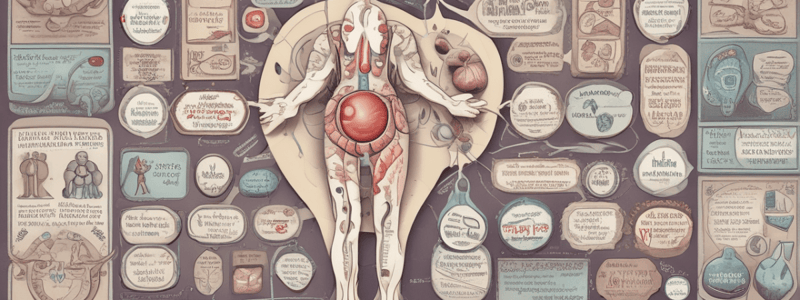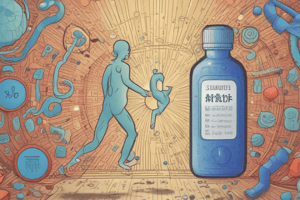Podcast
Questions and Answers
What percentage of patients may develop type 2 diabetes within 10 to 15 years after subsiding?
What percentage of patients may develop type 2 diabetes within 10 to 15 years after subsiding?
- 20%
- 40%
- 30% (correct)
- 50%
What is the HbA1C goal of treatment for diabetic patients?
What is the HbA1C goal of treatment for diabetic patients?
- Less than 9%
- Less than 6.5%
- Less than 8%
- Less than 7% (correct)
What is the fasting blood glucose goal for diabetic patients?
What is the fasting blood glucose goal for diabetic patients?
- 90 to 140 mg/dL
- 80 to 130 mg/dL (correct)
- 100 to 150 mg/dL
- 70 to 100 mg/dL
What is the duration of action for rapid-acting insulin aspart?
What is the duration of action for rapid-acting insulin aspart?
What is the peak of action for inhaled insulin Afrezza?
What is the peak of action for inhaled insulin Afrezza?
What is the duration of action for short-acting insulin regular?
What is the duration of action for short-acting insulin regular?
What is the duration of action for intermediate-acting insulin isophane suspension?
What is the duration of action for intermediate-acting insulin isophane suspension?
What is the characteristic of insulin glargine (Lantus)?
What is the characteristic of insulin glargine (Lantus)?
What is the primary cause of Type 1 Diabetes Mellitus?
What is the primary cause of Type 1 Diabetes Mellitus?
Which of the following is a characteristic of Diabetic Ketoacidosis (DKA)?
Which of the following is a characteristic of Diabetic Ketoacidosis (DKA)?
What is the typical percentage of patients with newly diagnosed Type 1 Diabetes Mellitus who present with Diabetic Ketoacidosis (DKA)?
What is the typical percentage of patients with newly diagnosed Type 1 Diabetes Mellitus who present with Diabetic Ketoacidosis (DKA)?
Which of the following comorbid conditions is commonly associated with Type 2 Diabetes Mellitus?
Which of the following comorbid conditions is commonly associated with Type 2 Diabetes Mellitus?
What is the term used to describe the collective comorbidities associated with Type 2 Diabetes Mellitus?
What is the term used to describe the collective comorbidities associated with Type 2 Diabetes Mellitus?
What is the primary concern in Gestational Diabetes?
What is the primary concern in Gestational Diabetes?
What is the hallmark of Hyperosmolar Hyperglycemic Syndrome (HHS)?
What is the hallmark of Hyperosmolar Hyperglycemic Syndrome (HHS)?
What is the common long-term complication of both Type 1 and Type 2 Diabetes Mellitus that affects the capillaries?
What is the common long-term complication of both Type 1 and Type 2 Diabetes Mellitus that affects the capillaries?
Which of the following situations would increase concerns for a patient with DM?
Which of the following situations would increase concerns for a patient with DM?
What is essential for thorough patient education regarding DM?
What is essential for thorough patient education regarding DM?
When administrating insulin, what should be checked before giving the insulin?
When administrating insulin, what should be checked before giving the insulin?
When drawing up two types of insulin in one syringe, what should be done?
When drawing up two types of insulin in one syringe, what should be done?
Why should metformin be discontinued if the patient is to undergo studies with contrast dye?
Why should metformin be discontinued if the patient is to undergo studies with contrast dye?
What should be administered to a conscious patient with hypoglycemia?
What should be administered to a conscious patient with hypoglycemia?
What should be monitored to assess therapeutic response to insulin?
What should be monitored to assess therapeutic response to insulin?
What is used to monitor long-term compliance with diet and drug therapy?
What is used to monitor long-term compliance with diet and drug therapy?
What is the mechanism of action of GLP-1 injectable medications in patients with type 2 diabetes?
What is the mechanism of action of GLP-1 injectable medications in patients with type 2 diabetes?
What is the primary adverse effect of SGLT2 inhibitors that led to a 2018 FDA warning?
What is the primary adverse effect of SGLT2 inhibitors that led to a 2018 FDA warning?
What is the primary indication for GLP-1 injectable medications in patients with type 2 diabetes?
What is the primary indication for GLP-1 injectable medications in patients with type 2 diabetes?
What is the primary action of SGLT2 inhibitors on glucose levels in patients with type 2 diabetes?
What is the primary action of SGLT2 inhibitors on glucose levels in patients with type 2 diabetes?
What is the primary contra-indication for SGLT2 inhibitors in patients with type 2 diabetes?
What is the primary contra-indication for SGLT2 inhibitors in patients with type 2 diabetes?
What is the primary nursing implication for patients taking antidiabetic medications and undergoing a test or procedure?
What is the primary nursing implication for patients taking antidiabetic medications and undergoing a test or procedure?
What is the primary treatment for mild hypoglycemia in patients with type 2 diabetes?
What is the primary treatment for mild hypoglycemia in patients with type 2 diabetes?
What is the primary adverse effect of DPP-4 inhibitors that can occur when used in conjunction with a sulfonylurea?
What is the primary adverse effect of DPP-4 inhibitors that can occur when used in conjunction with a sulfonylurea?
What is the main disadvantage of delaying insulin administration until hyperglycemia occurs?
What is the main disadvantage of delaying insulin administration until hyperglycemia occurs?
Which type of insulin is used as a basal insulin in Basal-Bolus Insulin Dosing?
Which type of insulin is used as a basal insulin in Basal-Bolus Insulin Dosing?
What is the first-line drug and most commonly used oral drug for the treatment of type 2 DM?
What is the first-line drug and most commonly used oral drug for the treatment of type 2 DM?
Which of the following is a common adverse effect of Sulfonylureas?
Which of the following is a common adverse effect of Sulfonylureas?
What is the mechanism of action of Thiazolidinediones?
What is the mechanism of action of Thiazolidinediones?
Which of the following is a contraindication for Alpha-glucosidase inhibitors?
Which of the following is a contraindication for Alpha-glucosidase inhibitors?
What is the mechanism of action of Incretin mimetics?
What is the mechanism of action of Incretin mimetics?
What is the preferred method of treatment for hospitalized patients with DM?
What is the preferred method of treatment for hospitalized patients with DM?
Flashcards are hidden until you start studying
Study Notes
Diabetes Mellitus
- Type 1 Diabetes Mellitus:
- Lack of insulin production or production of defective insulin
- Affected patients need exogenous insulin
- Complications include diabetic ketoacidosis (DKA) and hyperosmolar hyperglycemic syndrome (HHS)
- Type 2 Diabetes Mellitus:
- Most common type (90% of all cases)
- Caused by insulin deficiency and insulin resistance
- Many tissues are resistant to insulin, including reduced number of insulin receptors and less responsive insulin receptors
Signs and Symptoms of Diabetes
- Elevated fasting blood glucose (higher than 126 mg/dL) or a hemoglobin A1C (HbA1C) level greater than or equal to 6.5%
- Polyuria
- Polydipsia
- Polyphagia
- Glycosuria
- Unexplained weight loss
- Fatigue
- Blurred vision
Type 2 Diabetes Mellitus Comorbid Conditions
- Obesity
- Coronary heart disease
- Dyslipidemia
- Hypertension
- Microalbuminemia (protein in the urine)
- Increased risk for thrombotic (blood clotting) events
- These comorbidities are collectively referred to as metabolic syndrome, insulin-resistance syndrome, or syndrome X
Major Long-Term Complications of Both Types of Diabetes
- Macrovascular (atherosclerotic plaque):
- Coronary arteries
- Cerebral arteries
- Peripheral vessels
- Microvascular (capillary damage):
- Retinopathy
- Neuropathy
- Nephropathy
Gestational Diabetes
- Hyperglycemia that develops during pregnancy
- Insulin must be given to prevent birth defects
- Usually subsides after delivery
- 30% of patients may develop type 2 DM within 10 to 15 years
Nonpharmacologic Treatment Interventions
- Type 1: Always requires insulin therapy
- Type 2:
- Weight loss
- Improved dietary habits
- Smoking cessation
- Reduced alcohol consumption
- Regular physical exercise
Glycemic Goal of Treatment
- HbA1C of less than 7%
- Fasting blood glucose goal for diabetic patients: 80 to 130 mg/dL
Treatment Options for Diabetes
- Type 1: Insulin therapy
- Type 2:
- Lifestyle changes
- Oral drug therapy
- Insulin when the above no longer provide glycemic control
Insulin
- Function as a substitute for the endogenous hormone
- Effects are the same as normal endogenous insulin
- Restores the diabetic patient's ability to:
- Metabolize carbohydrates, fats, and proteins
- Store glucose in the liver
- Convert glycogen to fat stores
Types of Insulin
- Rapid-acting:
- Onset of action: 5 to 15 minutes
- Peak: 1 to 2 hours
- Duration: 3 to 5 hours
- Examples: insulin lispro (Humalog), insulin aspart (NovoLog), insulin glulisine (Apidra)
- Short-acting:
- Onset: 30 to 60 minutes
- Peak: 2.5 hours
- Duration: 6 to 10 hours
- Examples: regular insulin (Humulin R)
- Intermediate-acting:
- Onset: 1 to 2 hours
- Peak: 4 to 8 hours
- Duration: 10 to 18 hours
- Examples: insulin isophane suspension (NPH)
- Long-acting:
- Onset: 1 to 2 hours
- Peak: none
- Duration: 24 hours
- Examples: insulin glargine (Lantus), insulin detemir (Levemir)
Sliding Scale vs Bolus Insulin Dosing
- Sliding-scale insulin dosing:
- SUBQ rapid-acting or short-acting insulins are adjusted according to blood glucose test results
- Typically used in hospitalized diabetic patients or those on total parenteral nutrition or enteral tube feedings
- Basal-bolus insulin dosing:
- Preferred method of treatment for hospitalized patients with DM
- Mimics a healthy pancreas by delivering basal insulin constantly as a basal and then as needed as a bolus
- Basal insulin is a long-acting insulin (insulin glargine), and bolus insulin is a rapid-acting insulin (insulin lispro or insulin aspart)
Non-Insulin Antidiabetic Drugs
- Biguanides:
- Mechanism of action: decrease production of glucose by the liver, decrease intestinal absorption of glucose, and increase uptake of glucose by tissues
- Adverse effects: primarily affects gastrointestinal (GI) tract, may also cause metallic taste, reduced vitamin B12 levels
- Contraindications: renal or hepatic disease
- Example: metformin (Glucophage)
- Sulfonylureas:
- Mechanism of action: stimulate insulin secretion from the beta cells of the pancreas, thus increasing insulin levels
- Adverse effects: hypoglycemia, hematologic effects, nausea, epigastric fullness, heartburn
- Contraindications: hypersensitivity to Sulphur, pregnancy
- Examples: glimepiride (Amaryl), glipizide (Glucotrol), glyburide (DiaBeta)
- Glinides:
- Mechanism of action: similar to sulfonylureas, increase insulin secretion from the pancreas
- Adverse effects: hypoglycemia, weight gain
- Examples: repaglinide (Prandin), nateglinide (Starlix)
- Thiazolidinediones (glitazones):
- Mechanism of action: decrease insulin resistance, increase glucose uptake and use in skeletal muscle
- Adverse effects: can cause or exacerbate heart failure, peripheral edema, weight gain, decreased bone marrow density
- Contraindications: heart failure
- Example: pioglitazone (Actos)
- Alpha-glucosidase inhibitors:
- Mechanism of action: decrease intestinal absorption of glucose
- Adverse effects: flatulence, diarrhea, abdominal pain
- Contraindications: certain bowel disorders
- Examples: acarbose (Precose), miglitol (Glyset)
- Incretin mimetics:
- Mechanism of action: mimic naturally secreted incretin hormones, increase insulin synthesis and lower glucagon secretion
- Adverse effects: upper respiratory tract infection, headache, diarrhea
- Contraindications: pancreatitis
- Examples: sitagliptin (Januvia), saxagliptin (Onglyza), linagliptin (Tradjenta), alogliptin (Nesina)
- SGLT2 inhibitors:
- Mechanism of action: inhibit SGLT2, leading to a decrease in blood glucose caused by an increase in renal glucose excretion
- Adverse effects: genital yeast infections, urinary tract infections, increased urination
- Contraindications: diabetic ketoacidosis, moderate to severe kidney impairment
- Examples: canagliflozin (Invokana), dapagliflozin (Farxiga), empagliflozin (Jardiance), ertugliflozin (Steglatro)
Studying That Suits You
Use AI to generate personalized quizzes and flashcards to suit your learning preferences.




